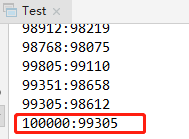- 【六】阿伟开始搭建Kafka学习环境
能源恒观
中间件学习kafkaspring
阿伟开始搭建Kafka学习环境概述上一篇文章阿伟学习了Kafka的核心概念,并且把市面上流行的消息中间件特性进行了梳理和对比,方便大家在学习过程中进行对比学习,最后梳理了一些Kafka使用中经常遇到的Kafka难题以及解决思路,经过上一篇的学习我相信大家对Kafka有了初步的认识,本篇将继续学习Kafka。一、安装和配置学习一项技术首先要搭建一套服务,而Kafka的运行主要需要部署jdk、zook
- JVM、JRE和 JDK:理解Java开发的三大核心组件
Y雨何时停T
Javajava
Java是一门跨平台的编程语言,它的成功离不开背后强大的运行环境与开发工具的支持。在Java的生态中,JVM(Java虚拟机)、JRE(Java运行时环境)和JDK(Java开发工具包)是三个至关重要的核心组件。本文将探讨JVM、JDK和JRE的区别,帮助你更好地理解Java的运行机制。1.JVM:Java虚拟机(JavaVirtualMachine)什么是JVM?JVM,即Java虚拟机,是Ja
- 【开发环境搭建】Macbook M1搭建Java开发环境
weixin_44329069
java开发语言
JDK安装与配置下载并安装JDK:ARM64DMG安装包下载链接:JDK21forMac(ARM64)。双击下载的DMG文件,按照提示安装JDK。配置环境变量:打开终端,使用vim编辑.bash_profile文件:vim~/.bash_profile在文件中添加以下内容来设置JAVA_HOME:exportJAVA_HOME=/Library/Java/JavaVirtualMachines/j
- 【编程底层原理】HashMap Hashtable ConcurrentHashMap
Dylanioucn
开发语言后端java
在Java的不同版本中,集合的实现原理有所变化,尤其是在HashMap、Hashtable和ConcurrentHashMap这三种实现中。以下是它们的一些关键区别和实现原理:一、HashMapJDK1.7:HashMap使用数组和链表的组合来解决冲突。当一个桶(数组的每个位置)中的元素超过一定数量时,会使用链表来存储这些元素。HashMap在JDK1.7中不是线程安全的。JDK1.8:进行了优化
- 一文读懂ZGC
w_rcss
垃圾回收JVMZGC垃圾回收器gcjvmG1
ZGC(TheZGarbageCollector)前言ZGC是G1后新推出的垃圾回收器,jdk11仅支持linux,jdk14增加了对windows,macOS的支持。本文将通过对比G1来简单介绍ZGC。什么是ZGC?ZGC(TheZGarbageCollector)是标记-整理算法的并发垃圾回收器,官方解释ZGC只是个名字,没有意义。//开启ZGC-XX:+UnlockExperimentalV
- Java高并发编程详解系列-深入理解Thread构造
nihui123
高并发Java高并发Java高并发
上篇分享中主要是对线程的基本概念和基本操作做了一个分享,同时提出了两种常用的创建多线程的方法,当然在后期的分享中也会提及到更多的创建线程的方式,到后期的分享的时候再说。这次主要是深入的理解一下Thread的构造函数,通过构造函数对于Thread有一个更加深入的了解。这里首先提供一个JDK1.6的ThreadAPI截图线程命名规范 从源码分析可以看到在Thread类中默认提供了线程的命名方式,这个
- 增强for循环 (for each循环)详解
blaizeer
Javajava
“我们仍需共生命的慷慨与繁华相爱,即使岁月以刻薄和荒芜相欺”文章目录前言文章有误敬请斧正不胜感恩!增强for循环1.遍历数组2.遍历字符串数组3.遍历集合(如List)4.遍历Set集合5.遍历Map的键值对6.遍历二维数组7.遍历对象数组总结前言写在开始:增强for循环(也称foreach循环)是迭代器遍历方法的一个“简化版”,是JDK1.5以后出来的一个高级for循环,专门用来遍历数组和集合。
- 2.Jmeter安装配置,核心目录详情,组件和作用域
XXX-17
Jmeterjmeter软件测试接口测试
一、Jmeter安装配置以及核心目录详情Jmeter基于java语言来开发,java需要jdk环境。1.安装jdk并且配置jdk的环境变量。2.jmeter只需要解压就可以使用了。3.在D:\apache-jmeter-5.5\bin目录下双击jmeter.bat文件就可以启动使用了backups:自动备份的目录bin:启动文件、配置文件(jmeter.bat是启动问题,jmeter.propti
- [附源码]SSM计算机毕业设计游戏账号交易平台JAVA
计算机程序源码
java游戏mysql
项目运行环境配置:Jdk1.8+Tomcat7.0+Mysql+HBuilderX(Webstorm也行)+Eclispe(IntelliJIDEA,Eclispe,MyEclispe,Sts都支持)。项目技术:SSM+mybatis+Maven+Vue等等组成,B/S模式+Maven管理等等。环境需要1.运行环境:最好是javajdk1.8,我们在这个平台上运行的。其他版本理论上也可以。2.ID
- String方法(JDK9)
凯哥学堂
声明:本栏目所使用的素材都是凯哥学堂VIP学员所写,学员有权匿名,对文章有最终解释权;凯哥学堂旨在促进VIP学员互相学习的基础上公开笔记。String方法(JDK9)构造器:String#String()无参数构造器,默认给的是一个””空字符串String#String(java.lang.String)给你一个char数组,它就帮你进行ABCD输出GBK中文简体+繁体字符集GB2312中文简体字
- Java 学习路线:语言、框架、中间件与数据库
高危型
java
Java是一门功能强大、应用广泛的编程语言,适用于企业级应用、Web开发、大数据处理、Android开发等各种场景。这里为大家介绍了一下我认为较为合适的学习路线一、Java基础1.1Java语言基础1.1.1安装JDK和IDE安装JDK:下载JDK:访问Oracle官网,下载最新的JavaDevelopmentKit(JDK)。安装JDK:按照操作系统要求安装JDK并配置环境变量。Windows上
- Python+Django毕业设计校园易购二手交易平台(程序+LW+部署)
Python、JAVA毕设程序源码
课程设计javamysql
项目运行环境配置:Jdk1.8+Tomcat7.0+Mysql+HBuilderX(Webstorm也行)+Eclispe(IntelliJIDEA,Eclispe,MyEclispe,Sts都支持)。项目技术:SSM+mybatis+Maven+Vue等等组成,B/S模式+Maven管理等等。环境需要1.运行环境:最好是javajdk1.8,我们在这个平台上运行的。其他版本理论上也可以。2.ID
- SpringBoot3与SpringBoot2的区别
bjzhang75
springboot
文章目录1、JDK环境2、SpringFramework版本3、主要变化和新特性3.1配置变化3.2GraalVM3.3安全性改进3.4性能优化3.4.1启动时间3.4.2内存使用3.5改进的依赖管理3.6全新启动器3.7Kotlin支持SpringBoot3与SpringBoot2的区别1、JDK环境SpringBoot3最低要求JDK17SpringBoot2最低要求JDK82、SpringF
- 【LINUX】在ubuntu中安装tomcat
缘起性本空
linux运维服务器
#instaljdkaptinstallopenjdk-8-jdk-y#enterinstallpathcd/home/a/#copytomcatpackagecp/mnt/hgfs/Share/apache-tomcat-9.0.93.tar.gz.#unpresstomcatpackagetar-xfapache-tomcat-9.0.93.tar.gz#enterbinpathcdapach
- java中的ide、sdk是什么,javaee\javase\javame区别
极客Thomas
idejavaeclipse
ide:integrateddevelopmentenvironment集成开发环境简单的来说就是提供编译代码等一系列功能的开发环境比如:eclipsesdk:servicedevelopmentpack服务开发包简单来说就是一些封装的功能代码,做成了一个包,给我们可以直接调用比如jdk1.8jdkjavase(JavaPlatform,StandardEdition)标准版本,在电脑上运行jav
- Java面试必问之Hashmap底层实现原理(JDK1.7)
当我遇上你csy
Java基础javahashmap面试源码
1.前言Hashmap可以说是Java面试必问的,一般的面试题会问:Hashmap有哪些特性?Hashmap底层实现原理(get\put\resize)Hashmap怎么解决hash冲突?Hashmap是线程安全的吗?…今天就从源码角度一探究竟。笔者的源码是OpenJDK1.72.构造方法首先看构造方法的源码//默认初始容量staticfinalintDEFAULT_INITIAL_CAPACIT
- 搭建Kafka+zookeeper集群调度
krb___
kafka分布式
前言硬件环境172.18.0.5kafkazk1Kafka+zookeeperKafkaBroker集群172.18.0.6kafkazk2Kafka+zookeeperKafkaBroker集群172.18.0.7kafkazk3Kafka+zookeeperKafkaBroker集群软件环境zookeeper3.5.9资源调度、写作Kafka2.8.0消息通信中间件安装JDK1.8安装搭建zo
- 长安链java-sdk打成jar包部署找不到配置文件,springBoot项目制作Docker镜像
FAFU_kyp
长安链JAVA基础知识#Dockerjavajar开发语言长安链
长安链使用sdk_config.yml的形式来引入用户的各种证书文件,但是打成jar包部署在服务器上会提示找不到文件。由于国内对镜像的限制,我选用了阿里的龙蜥镜像,里面提供java1.8的环境,因为长安链要1.8的环境dockerpull anolis-registry.cn-zhangjiakou.cr.aliyuncs.com/openanolis/openjdk:8-8.6解决方案就是制作成
- Android移动测试入门—— adb 测试环境搭建及常用命令
蘑菇头上不长草
Androidadbpython爬虫requestandroid
目录搭建abd环境安装jdk并配置环境变量安装adb并配置环境常用命令连接设备1.打开开发者模式2.USB连接移动设备3.查看连接设备4.进入手机5.adbpush电脑文件上传到手机6.adbpull从手机里下载文件到电脑7.adbinstall安装app8.查看手机上安装的所有软件(查看包名)9.卸载app10.monkey测试11.logcat搭建abd环境adb环境搭建主要分为2部分,一是j
- 登录校验实现——Jwt、Filter/Interceptor
应起忆
javaspring
Jwt令牌生成引入依赖,JDK8之后的版本需要引入JAXBjavax.xml.bindjaxb-api2.3.1org.glassfish.jaxbjaxb-runtime2.3.1io.jsonwebtokenjjwt0.9.1写JwtUtilsimportio.jsonwebtoken.Claims;importio.jsonwebtoken.Jwts;importio.jsonwebtoke
- springboot宠物咖啡馆平台的设计与实现
然然学长
springboot宠物java后端intellij-idea开发语言
运行环境环境说明:开发语言:java框架:springboot,vueJDK版本:JDK1.8数据库:mysql5.7+(推荐5.7,8.0也可以)数据库工具:Navicat11+开发软件:idea/eclipse(推荐idea)Maven包:Maven3.3.9+系统详细实现管理员模块的实现用户信息管理基于SpringBoot的宠物咖啡馆平台的设计与实现的系统管理员可以管理用户,可以对用户信息添
- Java基础day08ArrayList和继承
没有信仰的小白
ArrayList类对象数组数组长度是固定,无动态扩容java.util.ArrayList集合类,更方便image无参构造函数image基本格式,Jdk7之后右侧尖括号可以留空,但是必须保留ArrayListlist=newArrayList<>();成员方法添加元素publicbooleanadd(Ee)获取元素publicEget(intindex)集合中的元素publicintsize()
- springboot整合Logback
星空下夜猫子
springbootlogback后端
Logback介绍描述Logback是由log4j创始人设计的另外一种开源日志组件,性能比log4j要好。相对是一个可靠、通用、快速而又灵活的Java日志框架。Logback主要分三个模块1、logback-core:其他两个模块的基础模块2、logback-classic:它是log4j的一个改良版本,同时它完整实现了slf4j。API,可以很方便地更换成其它日志系统,如log4j或JDK14L
- 使用Java对PDF进行电子签章
cesske
javapdfpython
项目中用到电子签章(给PDF盖章签名),下边介绍一下怎么实现:准备工作:1、待盖章的pdf2、印章图片3、keystore证书文件把三个文件存在电脑的某个目录下,盖章时会用到。现在来讲一下keystore证书的生成:假定JDK已经安装,并配置系统变量,搜索cmd选择管理员身份打开"C:\ProgramFiles\Java\jdk1.8.0_271\bin\keytool.exe"-genkey-a
- Java学习路线:从零基础到高级开发者的完整指南
何遇mirror
java
初学者入门指南1.环境搭建安装JDK:下载并安装最新版本的JDK(JavaDevelopmentKit)。配置环境:设置JAVA_HOME环境变量,并将bin目录添加到PATH中。选择IDE:使用Eclipse、IntelliJIDEA或其他任何你喜欢的Java集成开发环境。2.Java基础知识HelloWorld:编写你的第一个Java程序。基本语法:学习变量、数据类型(原始类型、包装类型)、运
- 笔记:Centos Jdk Nginx 安装包安装命令
贰十六
笔记javanginx
#官方网址#Nginx官网http://nginx.org/#推荐:下载地址http://nginx.org/download/nginx-1.20.2.tar.gz#安装Nginx#进入到usr中的src,把刚才下载的安装包拉进去cd/usr/src/#解压安装包tarzxvfnginx-1.6.2.tar.gz#进入安装包目录cdnginx-1.6.2#编译安装./configure--wit
- Java初级学习路线概要~
艾伦~耶格尔
Java初级java学习开发语言intellij-ideajdk
前言如果你刚刚开始学习Java,掌握基础知识是关键。本文将提供一个详细的Java初级学习路线,帮助各位看官从基础开始,逐步掌握Java编程语言的核心概念。1.Java语言基础1.1Java简介-**Java介绍**:Java是一种广泛使用的编程语言,以其跨平台特性和面向对象设计而著名。-**应用场景**:Web应用、桌面应用、移动应用等。1.2环境搭建**安装JDK**:从[Oracle官网](h
- Java面试题真题·技术面试题部分总结
攸攸太上
Java面试题总结--攸攸太上java学习
系列文章目录Java面试题真题·技术面试题部分总结Java面试题真题·融资管理系统项目介绍文章目录系列文章目录前言技术问题Java的跨平台原理String常用方法分布式的优点对cookie有什么了解,Cookie和Session的区别最熟悉jdk哪个版本redis的部署方式mysql的配置和安装熟不熟悉如何配置多集群mysqlspringboot分布式有了解吗http和https的区别,https
- 第 2-2 课:深入探究底层原理,应用更加得心应手
Java大联盟
案例上手Spring全家桶SpringSpringBootSpringCloudSpringMVCSpringSpringBootSpring
前言上一讲我们学习了SpringMVC框架的使用,为了更好地理解这个框架,本讲来仿写一个SpringMVC框架,用到的技术比较简单,只需要XML解析+反射就可以完成,不需要JDK动态代理。自己手写框架的前提是必须理解框架的底层原理和运行机制,因此我们还是先来回顾一下SpringMVC的实现原理。SpringMVC实现原理SpringMVC的核心组件和工作流程的内容具体可以参考第2-1讲的内容,通过
- Linux搭建Java环境之jdk1.8安装图文教程
yundashi168
Java教程阿里云教程
Linux的使用相信大家都要用到java吧!在使用java前我们得先安装jdk以及配置环境变量等工作;下面小编给大家分享关于Linux安装jdk的详细步骤:【Linux服务器远程连接工具】xshell6快捷下载,xftp6快捷下载温馨提示:xshell负责编写和执行Linux命令,就是大家都知道的命令行。xftp负责上传和下载文件。两款软件搭配使用。还有一款免费的国产的linux远程连接客户端—f
- java杨辉三角
3213213333332132
java基础
package com.algorithm;
/**
* @Description 杨辉三角
* @author FuJianyong
* 2015-1-22上午10:10:59
*/
public class YangHui {
public static void main(String[] args) {
//初始化二维数组长度
int[][] y
- 《大话重构》之大布局的辛酸历史
白糖_
重构
《大话重构》中提到“大布局你伤不起”,如果企图重构一个陈旧的大型系统是有非常大的风险,重构不是想象中那么简单。我目前所在公司正好对产品做了一次“大布局重构”,下面我就分享这个“大布局”项目经验给大家。
背景
公司专注于企业级管理产品软件,企业有大中小之分,在2000年初公司用JSP/Servlet开发了一套针对中
- 电驴链接在线视频播放源码
dubinwei
源码电驴播放器视频ed2k
本项目是个搜索电驴(ed2k)链接的应用,借助于磁力视频播放器(官网:
http://loveandroid.duapp.com/ 开放平台),可以实现在线播放视频,也可以用迅雷或者其他下载工具下载。
项目源码:
http://git.oschina.net/svo/Emule,动态更新。也可从附件中下载。
项目源码依赖于两个库项目,库项目一链接:
http://git.oschina.
- Javascript中函数的toString()方法
周凡杨
JavaScriptjstoStringfunctionobject
简述
The toString() method returns a string representing the source code of the function.
简译之,Javascript的toString()方法返回一个代表函数源代码的字符串。
句法
function.
- struts处理自定义异常
g21121
struts
很多时候我们会用到自定义异常来表示特定的错误情况,自定义异常比较简单,只要分清是运行时异常还是非运行时异常即可,运行时异常不需要捕获,继承自RuntimeException,是由容器自己抛出,例如空指针异常。
非运行时异常继承自Exception,在抛出后需要捕获,例如文件未找到异常。
此处我们用的是非运行时异常,首先定义一个异常LoginException:
/**
* 类描述:登录相
- Linux中find常见用法示例
510888780
linux
Linux中find常见用法示例
·find path -option [ -print ] [ -exec -ok command ] {} \;
find命令的参数;
- SpringMVC的各种参数绑定方式
Harry642
springMVC绑定表单
1. 基本数据类型(以int为例,其他类似):
Controller代码:
@RequestMapping("saysth.do")
public void test(int count) {
}
表单代码:
<form action="saysth.do" method="post&q
- Java 获取Oracle ROWID
aijuans
javaoracle
A ROWID is an identification tag unique for each row of an Oracle Database table. The ROWID can be thought of as a virtual column, containing the ID for each row.
The oracle.sql.ROWID class i
- java获取方法的参数名
antlove
javajdkparametermethodreflect
reflect.ClassInformationUtil.java
package reflect;
import javassist.ClassPool;
import javassist.CtClass;
import javassist.CtMethod;
import javassist.Modifier;
import javassist.bytecode.CodeAtt
- JAVA正则表达式匹配 查找 替换 提取操作
百合不是茶
java正则表达式替换提取查找
正则表达式的查找;主要是用到String类中的split();
String str;
str.split();方法中传入按照什么规则截取,返回一个String数组
常见的截取规则:
str.split("\\.")按照.来截取
str.
- Java中equals()与hashCode()方法详解
bijian1013
javasetequals()hashCode()
一.equals()方法详解
equals()方法在object类中定义如下:
public boolean equals(Object obj) {
return (this == obj);
}
很明显是对两个对象的地址值进行的比较(即比较引用是否相同)。但是我们知道,String 、Math、I
- 精通Oracle10编程SQL(4)使用SQL语句
bijian1013
oracle数据库plsql
--工资级别表
create table SALGRADE
(
GRADE NUMBER(10),
LOSAL NUMBER(10,2),
HISAL NUMBER(10,2)
)
insert into SALGRADE values(1,0,100);
insert into SALGRADE values(2,100,200);
inser
- 【Nginx二】Nginx作为静态文件HTTP服务器
bit1129
HTTP服务器
Nginx作为静态文件HTTP服务器
在本地系统中创建/data/www目录,存放html文件(包括index.html)
创建/data/images目录,存放imags图片
在主配置文件中添加http指令
http {
server {
listen 80;
server_name
- kafka获得最新partition offset
blackproof
kafkapartitionoffset最新
kafka获得partition下标,需要用到kafka的simpleconsumer
import java.util.ArrayList;
import java.util.Collections;
import java.util.Date;
import java.util.HashMap;
import java.util.List;
import java.
- centos 7安装docker两种方式
ronin47
第一种是采用yum 方式
yum install -y docker
- java-60-在O(1)时间删除链表结点
bylijinnan
java
public class DeleteNode_O1_Time {
/**
* Q 60 在O(1)时间删除链表结点
* 给定链表的头指针和一个结点指针(!!),在O(1)时间删除该结点
*
* Assume the list is:
* head->...->nodeToDelete->mNode->nNode->..
- nginx利用proxy_cache来缓存文件
cfyme
cache
user zhangy users;
worker_processes 10;
error_log /var/vlogs/nginx_error.log crit;
pid /var/vlogs/nginx.pid;
#Specifies the value for ma
- [JWFD开源工作流]JWFD嵌入式语法分析器负号的使用问题
comsci
嵌入式
假如我们需要用JWFD的语法分析模块定义一个带负号的方程式,直接在方程式之前添加负号是不正确的,而必须这样做:
string str01 = "a=3.14;b=2.71;c=0;c-((a*a)+(b*b))"
定义一个0整数c,然后用这个整数c去
- 如何集成支付宝官方文档
dai_lm
android
官方文档下载地址
https://b.alipay.com/order/productDetail.htm?productId=2012120700377310&tabId=4#ps-tabinfo-hash
集成的必要条件
1. 需要有自己的Server接收支付宝的消息
2. 需要先制作app,然后提交支付宝审核,通过后才能集成
调试的时候估计会真的扣款,请注意
- 应该在什么时候使用Hadoop
datamachine
hadoop
原帖地址:http://blog.chinaunix.net/uid-301743-id-3925358.html
存档,某些观点与我不谋而合,过度技术化不可取,且hadoop并非万能。
--------------------------------------------万能的分割线--------------------------------
有人问我,“你在大数据和Hado
- 在GridView中对于有外键的字段使用关联模型进行搜索和排序
dcj3sjt126com
yii
在GridView中使用关联模型进行搜索和排序
首先我们有两个模型它们直接有关联:
class Author extends CActiveRecord {
...
}
class Post extends CActiveRecord {
...
function relations() {
return array(
'
- 使用NSString 的格式化大全
dcj3sjt126com
Objective-C
格式定义The format specifiers supported by the NSString formatting methods and CFString formatting functions follow the IEEE printf specification; the specifiers are summarized in Table 1. Note that you c
- 使用activeX插件对象object滚动有重影
蕃薯耀
activeX插件滚动有重影
使用activeX插件对象object滚动有重影 <object style="width:0;" id="abc" classid="CLSID:D3E3970F-2927-9680-BBB4-5D0889909DF6" codebase="activex/OAX339.CAB#
- SpringMVC4零配置
hanqunfeng
springmvc4
基于Servlet3.0规范和SpringMVC4注解式配置方式,实现零xml配置,弄了个小demo,供交流讨论。
项目说明如下:
1.db.sql是项目中用到的表,数据库使用的是oracle11g
2.该项目使用mvn进行管理,私服为自搭建nexus,项目只用到一个第三方 jar,就是oracle的驱动;
3.默认项目为零配置启动,如果需要更改启动方式,请
- 《开源框架那点事儿16》:缓存相关代码的演变
j2eetop
开源框架
问题引入
上次我参与某个大型项目的优化工作,由于系统要求有比较高的TPS,因此就免不了要使用缓冲。
该项目中用的缓冲比较多,有MemCache,有Redis,有的还需要提供二级缓冲,也就是说应用服务器这层也可以设置一些缓冲。
当然去看相关实现代代码的时候,大致是下面的样子。
[java]
view plain
copy
print
?
public vo
- AngularJS浅析
kvhur
JavaScript
概念
AngularJS is a structural framework for dynamic web apps.
了解更多详情请见原文链接:http://www.gbtags.com/gb/share/5726.htm
Directive
扩展html,给html添加声明语句,以便实现自己的需求。对于页面中html元素以ng为前缀的属性名称,ng是angular的命名空间
- 架构师之jdk的bug排查(一)---------------split的点号陷阱
nannan408
split
1.前言.
jdk1.6的lang包的split方法是有bug的,它不能有效识别A.b.c这种类型,导致截取长度始终是0.而对于其他字符,则无此问题.不知道官方有没有修复这个bug.
2.代码
String[] paths = "object.object2.prop11".split("'");
System.ou
- 如何对10亿数据量级的mongoDB作高效的全表扫描
quentinXXZ
mongodb
本文链接:
http://quentinXXZ.iteye.com/blog/2149440
一、正常情况下,不应该有这种需求
首先,大家应该有个概念,标题中的这个问题,在大多情况下是一个伪命题,不应该被提出来。要知道,对于一般较大数据量的数据库,全表查询,这种操作一般情况下是不应该出现的,在做正常查询的时候,如果是范围查询,你至少应该要加上limit。
说一下,
- C语言算法之水仙花数
qiufeihu
c算法
/**
* 水仙花数
*/
#include <stdio.h>
#define N 10
int main()
{
int x,y,z;
for(x=1;x<=N;x++)
for(y=0;y<=N;y++)
for(z=0;z<=N;z++)
if(x*100+y*10+z == x*x*x
- JSP指令
wyzuomumu
jsp
jsp指令的一般语法格式: <%@ 指令名 属性 =”值 ” %>
常用的三种指令: page,include,taglib
page指令语法形式: <%@ page 属性 1=”值 1” 属性 2=”值 2”%>
include指令语法形式: <%@include file=”relative url”%> (jsp可以通过 include

